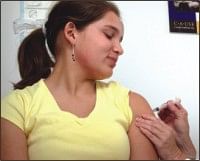Cervical cancer vaccine: Who needs it and how it works

A vaccine that offers protection from the Human papillomavirus (HPV) that is responsible for most cases of cervical cancer. Here is expert's insight into this revolutionary cervical cancer vaccine.
What is the significance of the cervical cancer vaccine?
The cervical cancer vaccine is the first vaccine ever designed to prevent a cancer. According to the World Health Organisation, there were 500,000 new cases of cervical cancer in 2005.
The tragedy of cervical cancer is that it often strikes when a woman is still young. She may be trying to raise her family or maybe she has not had children yet. Cervical cancer treatment may make future fertility impossible. And even with treatment, cervical cancer is a leading cause of cancer death in women.
When should the cervical cancer vaccine be given?
The cervical cancer vaccine is recommended for girls ages 11 to 12, although it may be used in girls as young as age 9. This allows a girl's immune system to be activated before she is likely to encounter HPV. Vaccinating at this age also allows for the highest antibody levels. The higher the antibody levels, the greater the protection.
The vaccine is given as a series of three injections over a six-month period. The second dose is given two months after the first dose, followed four months later by the third dose.
Does the vaccine offer benefits if you are already sexually active?
Yes. In clinical trials, the vaccine was effective in a group of sexually active women age 26 or younger, some of whom had already been infected with one or more types of HPV. There is a caveat, however.
The cervical cancer vaccine blocks HPV types 6, 11, 16 and 18, but only if you have not been exposed to those particular types of HPV. The more sexual partners you have had, the greater your chance of having been exposed to multiple types of HPV — including HPV types 6, 11, 16 and 18.
Does the vaccine carry any health risks or side effects?
The cervical cancer vaccine has proved to be remarkably safe. The most common complaint is soreness at the injection site, the upper arm. Low-grade fever or flu-like symptoms also are common. But the effects are usually mild. No one in the clinical trials discontinued the vaccination series because of side effects.
Will women still need to have Pap tests?
Absolutely. The cervical cancer vaccine is not intended to replace Pap tests. Routine screening for cervical cancer through regular pelvic exams and Pap tests remains an essential part of a woman's preventive health care.
What can you do to protect yourself from cervical cancer if your are not in the recommended vaccine age group?
HPV spreads through sexual contact. To protect yourself from HPV, use a condom during sex. It is also important to limit your number of sexual partners. Quitting smoking helps, too. Smoking doubles the risk of cervical cancer.
To detect cervical cancer in the earliest stages, have your Pap test or VIA test (Visual Inspection of cervix with Acetic Acid) done at a regular interval. Seek prompt medical attention if you notice any signs or symptoms of cervical cancer like vaginal bleeding after sex, between periods or after menopause; foul-smelling watery or bloody vaginal discharge; pelvic pain; or pain during sex.

 For all latest news, follow The Daily Star's Google News channel.
For all latest news, follow The Daily Star's Google News channel. 




Comments